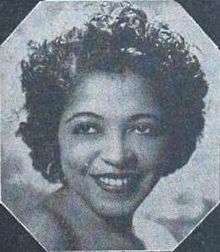Valaida Snow

Valaida Snow (June 2, 1904[1] – May 30, 1956) was an African-American jazz musician and entertainer.
Biography
She was born in Chattanooga, Tennessee. Raised on the road in a show-business family, she learned to play cello, bass, banjo, violin, mandolin, harp, accordion, clarinet, trumpet, and saxophone by the time she was 15. She also sang and danced.
.jpg)
After focusing on the trumpet, she quickly became so famous at the instrument that she was named "Little Louis" after Louis Armstrong, who called her the world's second best jazz trumpet player besides himself. Contemporary critics Krin Gabbard and Will Friedwald have commented on her approach to playing like Armstrong. Gabbard said she developed a "distinctly Armstrongian style" and Friedwald said she "mimicked" Armstrong.[2] In a 1928 performance in Chicago at the Sunset Café, Snow played the trumpet, sang. Then seven pairs of shoes were placed in a row at the front of the stage, and she danced in each pair for one chorus. The dances and shoes to match were: soft-shoe, adagio shoes, tap shoes, Dutch clogs, Chinese straw sandals, Turkish slippers, and the last pair, Russian boots. "When Louis Armstrong saw the show one night, he continued clapping after others had stopped and remarked, 'Boy I never saw anything that great'."[3][4] She played concerts throughout the US, Europe, and China. From 1926 to 1929 she toured with Jack Carter's Serenaders in Shanghai, Singapore, Calcutta, and Jakarta.
Her most successful period was in the 1930s when she became the toast of London and Paris. Around this time she recorded her hit song "High Hat, Trumpet, and Rhythm". She performed in the Ethel Waters show Rhapsody in Black, in New York. In the mid-1930s she made films with her husband, Ananias Berry, of the Berry Brothers dancing troupe. After playing the Apollo Theater in New York City, she revisited Europe and the Far East for more shows and films.
According to a jazz radio show that aired 10/28/2017, she claimed she was arrested in Europe, but in truth she was sent to jail for theft and illegal drugs. While touring through Denmark in 1941, she said she was arrested by Nazis and probably kept at Vestre Fængsel,[5] a Danish prison in Copenhagen that was run by the Nazis, before being released on a prisoner exchange in May 1942.[6] It was rumored that her friendship with a Belgium police official helped her board a ship carrying foreign diplomats.[7] According to jazz historian Scott Yanow, "she never emotionally recovered from the experience".[8] She married Earl Edwards. In the 1950s, she was unable to regain her former success.
Valaida Snow died of a brain hemorrhage on May 30, 1956, in New York City, backstage during a performance at the Palace Theater.
Performances
- March 11, 1933; Earl Hines and Snow performed in Madrid ballroom in Harrisburg, PA. [9]
Valaida Snow in literature
- John Edgar Wideman (1989). "Valaida". Fever: Twelve Stories. Henry Holt and Co. ISBN 978-0-8050-1184-5.
- Valaida Snow appears as a fictional character who threw herself on top of the protagonist when he was a child to shield him from a beating at the hands of the Nazis in a concentration camp. Snow is depicted as a strong, generous woman who proudly recalls that "They beat me, and fucked me in every hole I had. I was their whore. Their maid. A stool they stood on when they wanted to reach a little higher. But I never sang in their cage, Bobby. Not one note" (p. 28).
- Candace Allen (2004). Valaida. London: Virago. ISBN 978-1-84408-172-1.
- A novel based on Valaida Snow's life story.
- Mark Miller (2007). High Hat, Trumpet and Rhythm: The Life and Music of Valaida Snow. Toronto: The Mercury Press. ISBN 978-1-55128-127-8.
- Biography. Both the Allen and Miller books contradict the assertion that Snow was held by the Nazis and instead place her in Danish custody at a Copenhagen prison.
- Pascal Rannou (2008). Noire, la neige. Marseille: Editions Parenthèses. ISBN 978-2-86364-648-9.
- Inspired by Valaida's life, but it is more fictitious than strictly biographical.
- Valaida Snow, by Emmanuel Reuzé and Maël Rannou, comic strip, BDMusic, Paris, coll. " BDJazz ", 2012.
Family
Marriages According to an article posted in the Pittsburgh Courier in 1933, Snow was arrested and later acquitted of bigamy after eloping with her fiancé Ananias John W. Berry, Jr.[10]
- Sidney Lanier
- William Weldon Higgins (1888–1937), married around February 1924
- Russell T. Smith (de) (1890–1966), married 19 February 1925 in Mason City, Iowa
- Ananias John W. Berry, Jr. (1913–1951), married 18 May 1934, Lake County, Indiana
- Earl Edwards, married 1 October 1943 in Detroit
References
- ↑ Hackman, Florence. Vaudeville, Old & New: An Encyclopedia of Variety Performers in America. ISBN 978-0-415-93853-2. . Other presumed birth years are 1900, 1901, 1903, 1905, and 1907
- ↑ Lusane, Clarence (2003). Hitler's Black Victims: The Historical Experiences of Afro-Germans, European Blacks, Africans, and African Americans in the Nazi Era. p. 168.
- ↑ Reitz, Rosetta (1982). Hot Snow: Valaida Snow (Queen of the Trumpet Sings and Swings. Black American Literature Forum. p. 158.
- ↑ Devlin, Paul (2008). Snow, Valaida. New York: Oxford UP.
- ↑ Lusane, Clarence. Hitler's Black Victims: The Historical Experience of Afro-Germans, European Blacks, Africans and African Americans in the Nazi Era. ISBN 978-0-415-93295-0.
- ↑ Rye, Howard. L. Macy, ed. "Snow, Valaida [Valada, Little Louis]". Grove Music Online. Retrieved March 18, 2008.
- ↑ "Valaida Snow, Sunset Royal Ork And Alan Courtney at Apollo". The New York Age. April 10, 1943.
- ↑ Scott Yanow (2003). Jazz on Record: The First Sixty Years. Backbeat Books. p. 228. ISBN 0-87930-755-2.
- ↑ "Nite Club Orchestra at Madrid Tomorrow Nite". The Evening News(Harrisburg, Pennsylvania. March 3, 1933.
- ↑ "23 Dec 1933, Page 16 - The Pittsburgh Courier at Newspapers.com". Newspapers.com. 23 December 1933. Retrieved 17 May 2018.